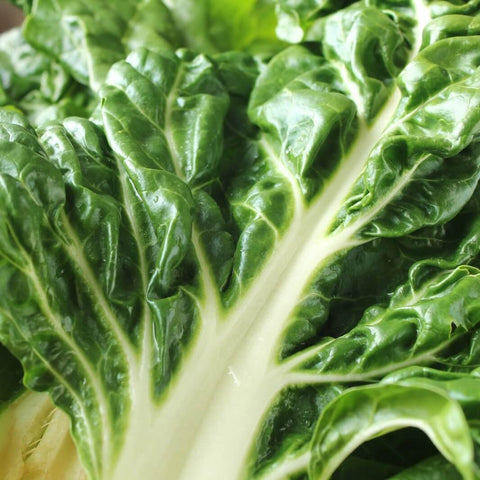

Hortinova
LUKULUS - Open Pollinated Swiss Chard Seeds
Beta vulgaris
- Early maturity: 60 days.
- An old favorite heirloom variety.
- Fine quality leaves, light green, deeply savoyed on thick, white, long, smooth stems.
- Particularly prolific and has a delicious mild, sweet flavor.
- Hardy and ornamental.
- Open-pollinated seeds.
- Natural, Untreated, Non-GMO Seeds.
Sow chard at wide spacings to produce large leaves for cooking or much closer together for baby salad leaves. Don't sow too early, as plants sown in the cold tend to flower prematurely (bolt).
FOR MATURE LEAVES: Make two sowings to supply large leaves throughout the year; one in mid-spring to crop in summer and fall, and one in midsummer to pick from fall to the following spring. Stretch a string across the bed and make a trench 1 in (2 cm) deep along it. Sow single seeds at 4 in (10 cm) intervals, cover with soil, water well, and label. Space rows 15—18 in (38—45 cm) apart. Plants can be raised in cell trays, on a windowsill, or outdoors, for transplanting when 2 in (5 cm) tall. Sowing in cells will give your chard plants a head start for summer salads. Sow one seed 1 in (2 cm) deep in the center of each cell, then cover with potting mix. Water well. Transplant seedlings by holding the root ball or leaves rather than the stem.
FOR BABY SALAD LEAVES: Between early spring and midsummer, sow successionally every 2-3 weeks into soil or large containers. Sow seeds 1 in (2 cm) deep, into single rows, spacing seeds roughly 2 in (5 cm) apart and rows 8 in (20 cm) apart; or sow into broad 6 in (15 cm) wide drills, spacing seeds roughly 2 in (5 cm) apart each way.
THIN: Each chard “seed” is actually a cluster of seeds that will produce several seedlings. Gradually thin them to 12 in (30 cm) apart for mature plants or 2 in (5 cm) apart for baby leaves. Thin chard sown in cells to one plant per cell after planting out.
PLANT OUT: Harden off young chard plants raised indoors by gradually acclimating them to outdoor conditions over a period of 7—10 days. Plant them out at 12 in (30 cm) intervals in rows 15-18 in (38—45 cm) apart if you want to harvest mature leaves, or at 2 in (5 cm) intervals in rows 8 in (20 cm) apart if your goal is to pick baby leaves.
WATER: Chard plants develop deep roots and can survive long dry spells without watering. However, they will yield more leaves given a thorough soak weekly during summer to keep the soil moist. Container-grown plants need regular watering. Apply a spring mulch around plants to retain moisture and suppress weed growth. Water red-stemmed varieties often as they are most prone to bolting.
PROTECT: Protect seedlings from slugs and snails with barriers and traps. Birds sometimes damage seedlings; cover with netting or fleece if this is a problem. For better-quality leaves to harvest during winter, cover rows with fleece tunnels.
Mature leaves are ready about 12 weeks after sowing. Start picking them from the outside of each plant by snapping or cutting the base of each stem. Pick off any flower stems that form to prolong the harvest. Harvest gradually as needed by cutting or snapping off the outer stems. Harvest mature plants all at once by cutting the stems at the base.
Let customers speak for us
from 23 reviewsWe grow several varieties of various colours of tomatoes, and the contrast of these tomatoes with other colours is fantastic. We've had a very long season with our plants, excellent disease resistance, great flavour.

This review applies to all of the seeds I purchased from Hortinova - beautiful tomatoes, good disease resistance and excellent production. Our field season extended to 10 weeks. We've had comments of excellent flavour from our customers as well, highly recommend any Hortinova seed.

This tomato is good taste tomato. Small red round tomato. Bigger then cherry tomatoes but smaller then regular one. I like it. Perfect for salads and fresh eating. Ordered seeds for next season.

2nd time ordering. Very satisfied with qualify and result. Thank you

BALCONY YELLOW F1 - Hybrid Cherry Tomato Seeds

Delivered very fast, packed very good, in professional condition and quality. Thanks

DUETT - Open Pollinated Radish Seeds

We will see what they are like this summer.

Type crimson de bonne grosseur avec une superbe uniformité et très hâtif. Un des premiers prêt en saison. Semences très petites et peu nombreuses. Goût très sucré et chaire croquante. Chair passant du rose au rouge en cours de saison. Les plants sont forts et très vigoureux avec des grosses feuilles.

Vigueur des plants impressionante avec des fruits résistants aux fissures et aux dommages. Très bonne conservartion et goût très sucré lorsque les nervures deviennent orange. Peu être récolté lorsque les nervures sont vertes également. Cavité des semences très compacte et petite laissant beaucoup de chair.

Melon qui fond en boûche avec un goût se rapprochant du melon miel et du cantaloup à la fois, très sucré. Faire attention aux irriguations lorsque le melon devient mature car il peut fendre au champs. Très odorant.

Avec son apparence côtellée, son très gros calibre et ça couleur rose, cette tomate se démarque des autres sur les tablettes. Variété plus résistante à la pourriture apicale que la plus part des autres tomates roses. Bon ensemble de résitance aux maladies également.

Tomate noire dont les faces qui ne sont pas exposé au soleil passent du vert au rouge lorsque mature donnant un aspect unique aux fruits. Charactéristiques similaires à la Barrio avec un goût superbe sans acide. Les clients l'on adoré.

Superbe adaptabilité et excellente résistance aux maladies. Fruits uniformes qui ne fendent pas, bonne conservation. Ajoutez à cela un goût unique avec une légère acidité et une pointe sucré.















